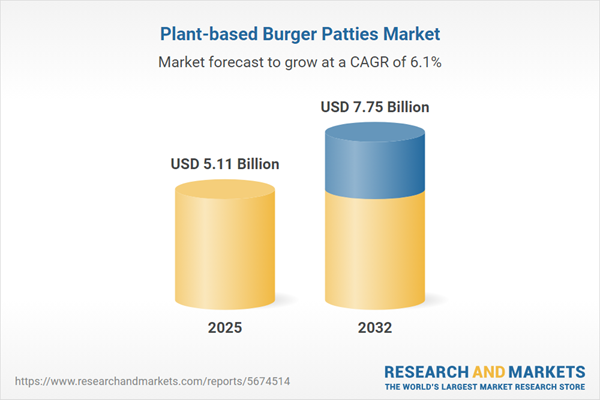Speak directly to the analyst to clarify any post sales queries you may have.
Senior decision-makers overseeing the plant-based burger patties market confront shifting consumer behaviors, expanding channel opportunities, and the mounting complexity of supply chain and regulatory demands. Navigating this landscape requires responsive strategies and clear insights to drive sustained growth and operational resilience.
Market Snapshot: Growth Trends in the Plant-Based Burger Patties Market
The plant-based burger patties market is in a phase of strong expansion, projected to grow from USD 4.82 billion in 2024 to USD 5.11 billion in 2025 and reach USD 7.75 billion by 2032. This equals a CAGR of 6.12%. Drivers include greater consumer health consciousness, growing investment in alternative protein innovation, and strategic efforts to secure ingredient supply. Market leaders are applying innovation across retail, food service, and digital channels, aiming to expand distribution and diversify product lines. Companies with multi-channel strategies that leverage consumer insights and optimize regional execution continue to redefine the competitive environment.
Scope & Segmentation: Strategic Insights for the Plant-Based Burger Patties Market
- Distribution Channels: E-commerce platforms, online supermarkets, cafeterias, quick-service and full-service restaurants, hypermarkets, supermarkets, specialty outlets, and convenience stores serve both direct consumers and commercial partners, supporting increased market penetration.
- Product Forms: Chilled, frozen, pre-cooked, and ready-to-cook formats are designed for operational versatility, shelf life optimization, and improved service delivery in retail and foodservice environments.
- Source Materials: Options such as pea, soy, and wheat proteins allow for nutritional diversity and enable portfolio adaptation for consumer and business needs.
- Price Tiers: Economy, mid-range, and premium segments allow businesses to align offerings with budget variations, responding flexibly to shifts in consumer value priorities across regions.
- Packaging Types: Bulk packaging supports efficiency for foodservice operations, while single-serve options meet demand for freshness and convenience across digital and traditional retail.
- Geographic Coverage: The Americas, Europe, Middle East, Africa, and Asia-Pacific each display unique adoption rates, regulatory conditions, and supply chain dynamics that require localized strategy planning and risk assessment.
- Corporate Landscape: Industry leaders—including Beyond Meat, Impossible Foods, Nestlé, Maple Leaf Foods, Kellogg, Conagra Brands, Tyson Foods, The Kraft Heinz Company, Unilever, and The Hain Celestial Group—drive standards through a sustained focus on product and process innovation.
Key Takeaways for Strategic Leadership
- Expanded ingredient innovation enables products to reach a wider consumer segment, leading to increased acceptance among those shifting away from animal-based proteins.
- Rising sustainability and ethical sourcing requirements create new benchmarks, prompting enhancements in procurement and manufacturing quality throughout the supply chain.
- Strategic supply chain collaborations and targeted investment in operational efficiency reinforce market reliability and support compliance amid changing regulation.
- Localized go-to-market approaches, complemented by targeted sustainability messaging, enhance brand loyalty and increase differentiation in mature and emerging regions.
- Greater integration of omni-channel distribution and digital platforms accelerates feedback loops, allowing businesses to respond rapidly to customer needs and emerging trend signals.
- Smart packaging design and increased traceability elevate transparency, promoting trust among stakeholders throughout the value chain and providing a competitive edge in regulated markets.
Tariff Impact Shaping U.S. Plant-Based Burger Patty Supply Chains
The implementation of new import tariffs in the U.S. has compelled manufacturers to invest more heavily in domestic sourcing for critical ingredients. This shift encourages tighter supplier relationships and alters sourcing strategies, prompting all partners within the plant-based burger patties supply network to realign cost structures and prioritize long-term supply security.
Methodology & Data Sources
This analysis draws on interviews with key suppliers, manufacturers, and distribution partners, as well as a thorough assessment of regulatory filings, patent literature, and recognized industry publications. Analytical models—SWOT, Porter’s Five Forces, and PESTEL—inform the strategic guidance, with scenario analysis and visual tools supporting practical decision-making.
Why This Report Matters: Optimizing B2B Strategy in the Plant-Based Burger Patties Market
- Translates market insights into strategies that support capital allocation, anticipate geographic demand shifts, and optimize channel performance across local and international markets.
- Clarifies regulatory and supply challenges, equipping leadership teams to identify risk exposures and strengthen supply continuity.
- Aligns diverse teams with actionable recommendations tailored to the specific needs of each business segment and channel.
Conclusion
Market leadership in the plant-based burger patties sector depends on a strong commitment to sustainability, innovation, and operational flexibility. Organizations that adapt technology and anticipate consumer preferences will be best prepared for future growth.
Additional Product Information:
- Purchase of this report includes 1 year online access with quarterly updates.
- This report can be updated on request. Please contact our Customer Experience team using the Ask a Question widget on our website.
Table of Contents
3. Executive Summary
4. Market Overview
7. Cumulative Impact of Artificial Intelligence 2025
List of Figures
Samples

LOADING...
Companies Mentioned
The key companies profiled in this Plant-based Burger Patties market report include:- Beyond Meat, Inc.
- Impossible Foods Inc.
- Nestlé S.A.
- Maple Leaf Foods Inc.
- Kellogg Company
- Conagra Brands, Inc.
- Tyson Foods, Inc.
- The Kraft Heinz Company
- Unilever PLC
- Hain Celestial Group, Inc.
Table Information
| Report Attribute | Details |
|---|---|
| No. of Pages | 187 |
| Published | October 2025 |
| Forecast Period | 2025 - 2032 |
| Estimated Market Value ( USD | $ 5.11 Billion |
| Forecasted Market Value ( USD | $ 7.75 Billion |
| Compound Annual Growth Rate | 6.1% |
| Regions Covered | Global |
| No. of Companies Mentioned | 11 |









